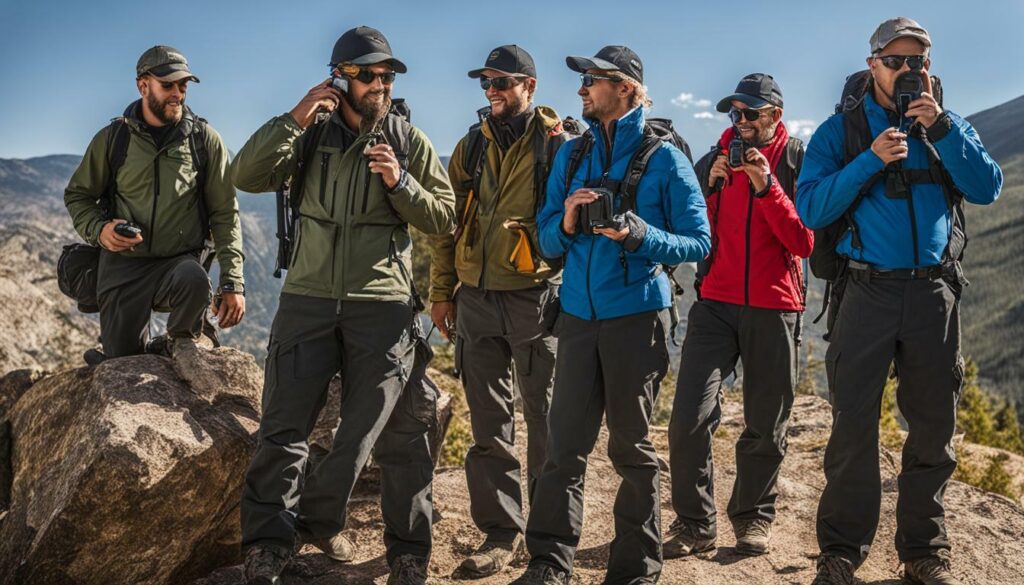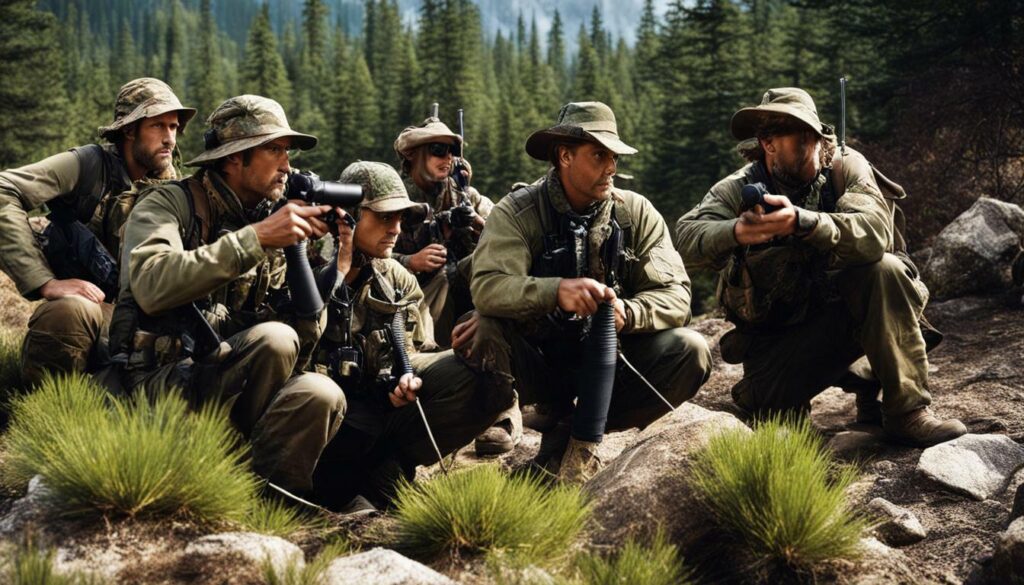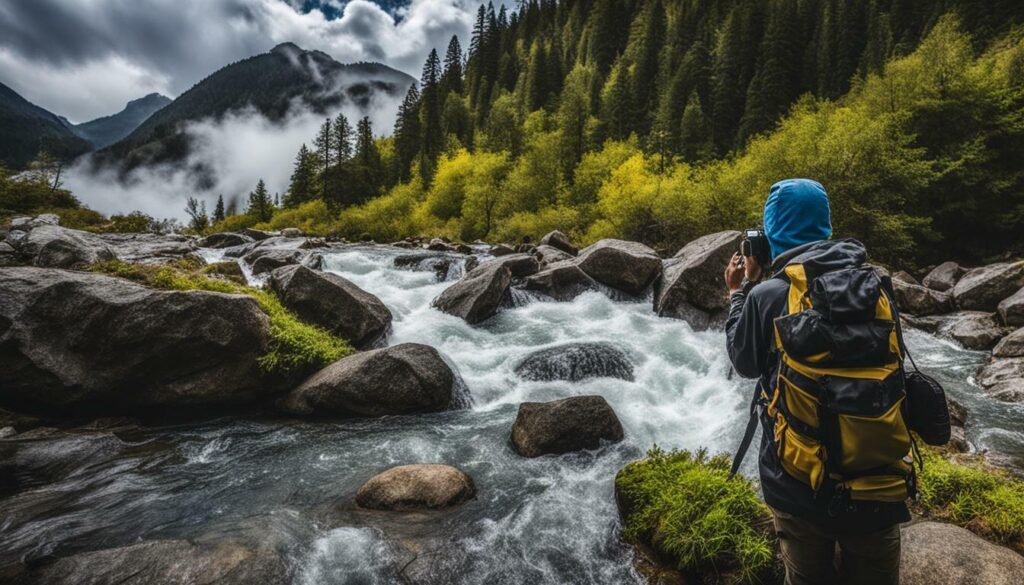Are you ready to embark on exciting outdoor adventures? Look no further than day hiking! Whether you’re a beginner or an experienced hiker, day hiking offers an accessible and enjoyable way to explore the beauty of nature at your own pace. From picturesque hiking trails to essential hiking gear, this guide has everything you need to make the most of your outdoor adventure.
Discover beginner-level hiking trails that are family-friendly and wheelchair-accessible. These trails, designed by Waterford Press in partnership with American Trails, are conveniently located in various states, making it easier for you to find nearby hiking options. With lightweight guides that include maps and illustrations, navigating the trails has never been easier.
In 2020, 52 million people across the country went hiking, highlighting the popularity of this outdoor activity. So why not join the millions of outdoor enthusiasts and start your own day hiking journey? Whether you’re looking to experience the tranquility of nature, challenge yourself physically, or spend quality time with loved ones, day hiking is the perfect choice.
Essential Hiking Gear: What to Look for When Buying
When it comes to enjoying a day hike, having the right gear is essential. Whether you’re a beginner or an experienced hiker, investing in high-quality hiking gear can make all the difference in your outdoor adventure. Here are some key items to consider when buying hiking gear:
Hiking Backpack
A hiking backpack is your trusty companion on the trail. Look for a backpack that is durable, lightweight, and has multiple compartments for organizing your gear. Consider the capacity of the backpack, ensuring it is large enough to carry your essentials without being too bulky.
Hiking Boots or Shoes
Comfortable and supportive footwear is crucial for a successful hike. Choose hiking boots or shoes that fit well and offer good traction. Look for waterproof or water-resistant options to keep your feet dry in wet conditions.
Hydration System
Staying hydrated is essential when hiking. Invest in a hydration system, such as a hydration bladder or water bottles, to ensure you have easy access to water on the trail. Look for systems that are leak-proof and easy to clean.
Navigation Tools
When venturing into the wilderness, it’s important to have navigation tools to help you find your way. Consider carrying a map, compass, or GPS device to ensure you stay on the right path. Familiarize yourself with how to use these tools effectively before hitting the trail.
Weather-Appropriate Clothing
Be prepared for changing weather conditions by dressing in layers. Look for moisture-wicking and quick-drying clothing materials to keep you comfortable during your hike. Don’t forget to pack a waterproof or windproof jacket in case of rain or strong winds.
First-Aid Kit
Accidents can happen on the trail, so carrying a comprehensive first-aid kit is crucial. Look for a kit that includes bandages, antiseptic wipes, pain relievers, and any necessary medication specific to your needs. Familiarize yourself with the contents of the kit and how to use them effectively.
Multi-Tool or Knife
A multi-tool or knife can come in handy for various tasks while hiking. Look for a compact and lightweight option that includes essential tools such as a knife, scissors, pliers, and screwdrivers.
Headlamp or Flashlight
If you plan on hiking during low-light conditions or staying overnight, a headlamp or flashlight is essential. Look for a lightweight and durable option with adjustable brightness settings. Don’t forget to pack extra batteries!
Emergency Shelter
Having a portable emergency shelter is important in case of unexpected circumstances, such as getting lost or extreme weather conditions. Look for a lightweight and compact option that can provide protection from rain, wind, and cold temperatures.
Nutritious Snacks and Meals
Ensure you have enough energy to sustain your hike by packing nutritious snacks and meals. Look for lightweight and easily portable options that provide a good balance of carbohydrates, protein, and fats. Don’t forget to pack enough water or a water filtration system.
By keeping these essential items in mind when buying hiking gear, you’ll be well-prepared for your next outdoor adventure. Remember to prioritize durability, weight, and functionality to ensure a safe and enjoyable hike.
Hiking Tips and Safety Precautions
When it comes to hiking, safety should always be a top priority. Whether you’re a beginner or an experienced hiker, following hiking tips and taking necessary safety precautions can make a significant difference in your overall experience. Here are some essential tips to keep in mind:
Do Your Research and Plan Ahead
Prior to your hike, take the time to research and gather information about the trail you’ll be embarking on. Look for trail maps, read reviews or blogs, and understand the difficulty level and any potential hazards. It’s also important to check the weather conditions for the day of your hike, as unexpected changes in weather can greatly impact your safety. Planning ahead will help you prepare accordingly and make informed decisions.
Dress Appropriately and Stay Hydrated
Choosing the right clothing and footwear is crucial for your comfort and safety on the trail. Dress in layers to adapt to changing weather conditions and wear sturdy, comfortable hiking boots or shoes that provide adequate support and traction. Additionally, staying hydrated is essential during your hike. Carry enough water and drink regularly to prevent dehydration.
Carry Essential Gear and Practice Hiking Etiquette
Be prepared by carrying essential gear such as a first-aid kit, a map and compass or GPS device, a headlamp or flashlight, extra food and water, and a multitool or knife. These items can prove invaluable in case of emergencies or unexpected situations. It’s also important to practice hiking etiquette by staying on designated trails, respecting wildlife, and leaving no trace behind.
By following these hiking tips and safety precautions, you can enhance your hiking experience and ensure a safe adventure on the trails. Remember to always prioritize your safety and be prepared for the unexpected. Happy hiking!


Hiking with Family, Kids, and Pets
Exploring the great outdoors is a fantastic way to bond with your family, create lasting memories with your kids, and even involve your pets in the adventure. Hiking with family, kids, and pets can be a fun and enjoyable experience, but it’s important to prepare and plan accordingly.
Family-Friendly Trails
When hiking with your family, it’s crucial to choose trails that are suitable for all ages and fitness levels. Look for beginner or intermediate-level trails that offer a variety of scenic views and manageable distances. You can also consider trails that have additional attractions such as waterfalls, picnic areas, or wildlife viewing spots to keep everyone engaged throughout the hike.
Before heading out, make sure to pack essential items such as snacks, water, and extra clothing for kids. It’s also a good idea to involve your children in the planning process, allowing them to choose the trail or be responsible for navigating using a child-friendly map or compass. This not only encourages their participation but also helps them develop a sense of responsibility and outdoor skills.
Hiking with Kids
When hiking with kids, it’s essential to keep them engaged and entertained. Incorporate nature-based games, scavenger hunts, or storytelling into the hike to make it more enjoyable for them. Encourage their curiosity by pointing out interesting plants, animals, or geological formations along the way. Don’t forget to take breaks to rest and refuel and allow them to explore their surroundings safely.
Hiking with Pets
If you plan to hike with your furry friends, it’s crucial to ensure they are allowed on the trails you choose. Research pet-friendly trails in advance and familiarize yourself with any rules or regulations regarding leashes and waste disposal. Keep your pets leashed at all times to maintain their safety and the safety of other hikers and wildlife. Remember to bring extra water and snacks for your pets and clean up after them to respect the environment and other hikers.
Hiking with family, kids, and pets can be a wonderful opportunity to enjoy nature, bond with loved ones, and create cherished memories. By choosing the right trails, involving everyone in the planning process, and ensuring the safety and comfort of all participants, you can have a fantastic hiking experience that everyone will treasure.
Gear Maintenance and Packing Tips
Proper gear maintenance is crucial for ensuring the longevity and functionality of your hiking gear. By implementing a few simple practices, you can keep your equipment in top shape and maximize its durability. Additionally, efficient packing is essential to ensure a smooth and hassle-free hiking experience. Here are some helpful gear maintenance and packing tips to consider:
1. Clean and Dry Your Gear
After each hike, it’s important to clean and dry your gear thoroughly. This helps prevent damage caused by dirt, sweat, moisture, and other environmental factors. Use a gentle cleaning solution and a soft brush to remove any dirt or debris from your hiking boots, backpack, and other gear. Once cleaned, ensure that everything is completely dry before storing it to avoid mold and mildew growth.
2. Pack Essential Items
When preparing for a hike, it’s crucial to pack essential items that will enhance your safety and comfort on the trail. Some key items to include in your backpack are a map, compass, water bottles or a hydration system, energy-rich snacks, a first-aid kit, a multi-tool or knife, rain gear, and extra clothing layers. Additionally, consider packing sunscreen, insect repellent, a headlamp or flashlight, and a small towel or bandana for various purposes.
3. Choose the Right Gear
Selecting the right gear is essential for a successful hiking experience. Consider the terrain, weather conditions, and duration of your hike when choosing equipment. Invest in high-quality hiking boots or shoes that provide comfort, support, and traction. Opt for moisture-wicking and breathable clothing that suits the weather conditions and layer appropriately. Additionally, choose a backpack that fits well and distributes weight evenly to minimize strain on your back and shoulders.
4. Pack Light
When it comes to hiking, packing light is key. Evaluate each item’s necessity and functionality before adding it to your backpack. Minimize weight by choosing lightweight and compact gear options. Streamline your packing list by opting for multipurpose items and minimizing duplicate items. Remember, a lighter backpack will not only make your hike more comfortable but also reduce strain and fatigue on your body.
| Item | Quantity |
|---|---|
| Hiking boots or shoes | 1 pair |
| Backpack | 1 |
| Water bottles or hydration system | 2-3 |
| Map and compass | 1 each |
| Energy-rich snacks | 1-2 servings |
| First-aid kit | 1 |
| Multi-tool or knife | 1 |
| Rain gear | 1 set |
| Extra clothing layers | 1-2 sets |
By following these gear maintenance and packing tips, you can ensure your hiking gear is ready for any adventure and that you’re properly equipped for a safe and enjoyable experience on the trail.


Finding and Enjoying Local Hiking Trails
When it comes to finding and enjoying local hiking trails, there are plenty of resources available to help you discover the perfect outdoor adventure. Trail directories such as AllTrails, Hiking Trails, and TrailLink provide comprehensive listings of hiking options in your area. Simply enter your location or preferred trail features, and you’ll be presented with a variety of trail choices to explore.
Consider your preferences when choosing a trail. Whether you’re looking for a leisurely stroll or a challenging ascent, trail directories offer filters to help you find the perfect fit. You can search by difficulty level, distance, scenery, and even dog-friendly options if you’re hiking with a furry companion.
Planning ahead is crucial to ensure a smooth and enjoyable hiking experience. Check the weather forecast before heading out, and pack accordingly. Dress in layers and wear appropriate footwear to stay comfortable on the trail. Don’t forget to bring water and snacks to keep yourself fueled and hydrated. And remember, always follow hiking etiquette and be respectful of nature by staying on designated trails and leaving no trace.
By exploring local hiking trails, you not only get to enjoy the beauty of your surroundings but also support your community by appreciating and preserving natural spaces. So lace up your hiking boots, grab your trail map, and embark on an adventure right in your own backyard. Happy hiking!
Conclusion
Day hiking is the perfect way to embark on an exciting outdoor adventure. With the right gear, preparation, and knowledge of hiking tips, you can have a memorable and enjoyable experience exploring nature. Whether you’re hiking alone or with family, kids, or pets, there are trails suitable for everyone’s abilities and interests.
By immersing yourself in local hiking trails, you can escape the hustle and bustle of daily life and connect with the beauty of the great outdoors. Day hiking allows you to experience the wonders of nature at your own pace, whether it’s admiring breathtaking views, discovering hidden gems, or simply enjoying the tranquility that nature provides.
Remember to follow hiking etiquette and leave no trace, respecting the environment and wildlife. Stay safe by being prepared, checking the weather conditions, and carrying essential items such as a map, compass, and first-aid kit. With these precautions in mind, you can fully embrace the joy of day hiking and create unforgettable memories along the way.
FAQ
Is day hiking suitable for beginners?
Yes, day hiking is a great activity for beginners. There are beginner-level trails that are family-friendly and wheelchair-accessible, making it easy for everyone to enjoy the outdoors.
What essential gear do I need for hiking?
Essential hiking gear includes a backpack, hiking boots or shoes, a hydration system, navigation tools such as a map or compass, weather-appropriate clothing, a first-aid kit, a multi-tool or knife, a headlamp or flashlight, an emergency shelter, and nutritious snacks and meals.
What are some important hiking tips and safety precautions?
It’s important to research and plan your hike, check the weather conditions, dress appropriately, stay hydrated, carry a first-aid kit, practice hiking etiquette, be aware of your surroundings, hike with a group or let someone know your plans, and be prepared for unexpected weather changes.
Can I go hiking with my family, kids, and pets?
Yes, day hiking is a great activity to enjoy with your family, kids, and even pets. Choose trails suitable for all ages and fitness levels when hiking with family. Keep your pets leashed and clean up after them to respect the environment when hiking with pets.
How should I maintain and pack my hiking gear?
Clean and dry your gear after each hike to prevent damage. Pack essential items such as a map, compass, water, snacks, and a first-aid kit. Choose the right gear for different types of terrain and seasons, pack light to avoid unnecessary weight, and consider using waterproof bags or covers to protect your gear from moisture.
Where can I find local hiking trails?
You can use trail directories such as AllTrails, Hiking Trails, or TrailLink to discover hiking options in your area. Consider your preferences, such as difficulty level, distance, and scenery, when choosing a trail. Check the weather and prepare necessary equipment before setting out.
How can I enhance my outdoor adventure through day hiking?
By exploring local hiking trails, appreciating nature, and following hiking tips and safety precautions, you can have a memorable and enjoyable hiking experience. Whether you’re hiking alone, with family, kids, or pets, there are trails suitable for everyone.








